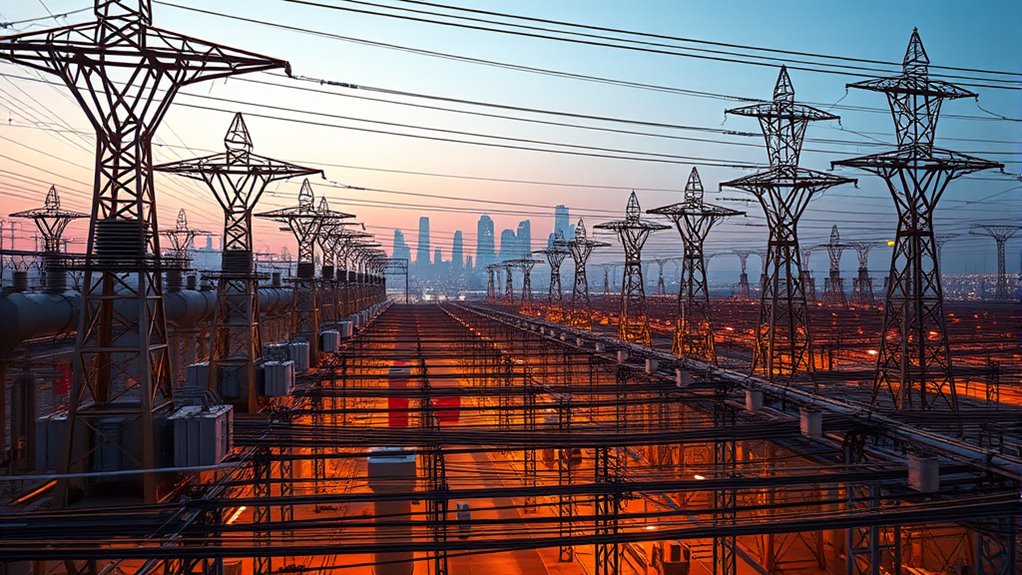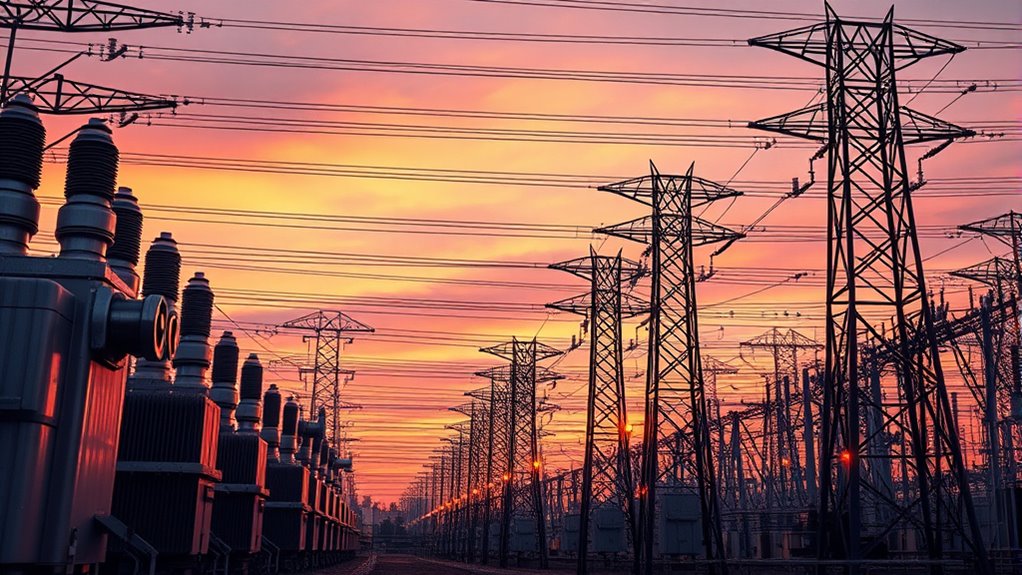The national electric grid can handle 50% EV adoption if it’s upgraded with smart technology, renewable energy sources, and energy storage systems. Modernizing infrastructure, managing peak loads, and balancing supply and demand are essential. Engineers believe that with these improvements, the grid will remain reliable and resilient as EV use grows. To understand how these solutions work and what’s needed for a seamless shift, keep exploring these innovative strategies.
Key Takeaways
- Upgrading grid infrastructure with smart technology is essential to manage increased EV charging demands effectively.
- Integrating renewable energy sources helps meet higher electricity needs while reducing reliance on fossil fuels.
- Implementing energy storage and V2G systems enhances grid capacity and stability during peak loads.
- Modernization efforts can prevent overloads and congestion, ensuring equitable and reliable power distribution.
- Strategic planning and technological investments are critical for maintaining grid resilience at 50% EV adoption.

As electric vehicle (EV) adoption reaches 50%, the demands on the national electric grid will intensify considerably. You might wonder if the current infrastructure can handle such a surge in electricity consumption. The answer depends on how well the grid can adapt through renewable integration and grid modernization. These two strategies are essential for managing increased load while maintaining stability and sustainability. Renewable integration involves incorporating more renewable energy sources, like solar and wind, into the grid. This not only reduces reliance on fossil fuels but also provides cleaner, more sustainable power to meet rising demand. As EV charging becomes more widespread, you’ll need a grid that can efficiently handle variable renewable inputs, which are often intermittent. The challenge lies in balancing supply and demand, especially during peak charging times, without risking blackouts or frequency instability.
Grid modernization plays a pivotal role in preparing for this transition. You should think of it as upgrading the existing infrastructure with advanced technologies such as smart meters, grid sensors, and automated control systems. These innovations enable real-time monitoring and dynamic management of electricity flows, making it easier to distribute power where it’s needed most. With a modernized grid, you can optimize the use of renewable energy, reduce transmission losses, and improve reliability. It also opens the door for vehicle-to-grid (V2G) technology, where EVs can act as distributed energy storage, feeding excess power back into the grid during high demand. This flexibility is essential for smoothing out fluctuations caused by renewable sources and EV charging patterns.
Furthermore, investments in grid modernization will help you better handle the spatial distribution of EV charging stations. Instead of overloading local transformers or creating congestion in specific areas, a smarter grid can direct power more efficiently, avoiding disruptions. An integrated approach to grid management that includes energy storage solutions can further enhance the grid’s capacity to manage increased load and intermittent energy sources. You should also consider how advanced grid technologies can be employed to improve overall system adaptability and resilience, especially in extreme weather conditions. These improvements will make the grid more adaptable and capable of supporting 50% EV adoption without compromising reliability or sustainability.
In essence, the future of the national electric grid hinges on your willingness to embrace technological advancements and strategic planning. By focusing on renewable integration and grid modernization, you can guarantee that the grid not only meets the demands of widespread EV adoption but also advances toward a cleaner, more resilient energy system. The transition is challenging, but with proactive upgrades and smarter management, it’s well within reach. Furthermore, integrating energy storage solutions can significantly enhance the grid’s capacity to manage increased load and intermittent energy sources.
Frequently Asked Questions
How Quickly Can the Grid Be Upgraded for Higher EV Demand?
Upgrading the grid for higher EV demand depends on how quickly you implement grid modernization and policy incentives. You can expect upgrades to accelerate as investments increase and regulations support infrastructure improvements. If policy incentives promote faster deployment, the process could be streamlined within a few years. Active planning and proactive investments are key to ensuring your grid can handle rising EV adoption efficiently and reliably.
What Are the Environmental Impacts of Increasing Grid Capacity?
As you increase grid capacity, you’ll likely see a positive impact on the environment. Expanding the grid enables more clean energy sources, which reduces carbon emissions from electricity generation. This shift improves air quality by cutting pollutants from fossil fuels. While building out infrastructure may have some environmental footprint, the long-term benefits include cleaner air and a smaller carbon footprint, supporting a healthier planet for everyone.
How Will Renewable Energy Integration Affect Grid Stability?
Think of renewable energy integration as adding new threads to a tapestry; it can strengthen grid resilience when managed well. You’ll see increased reliance on battery storage to smooth out fluctuations, ensuring stability. By diversifying energy sources, the grid becomes more adaptable and resilient, capable of handling peak demands. This synergy helps keep your power steady, even as renewable energy sources like wind and solar grow, making the grid smarter and more reliable.
What Role Do Energy Storage Systems Play in Managing Peak Loads?
Energy storage systems, like battery storage, play a vital role in managing peak loads by providing load balancing. When demand spikes, you can store excess energy and release it during high usage periods, preventing grid overloads. These systems help smooth out fluctuations, ensuring reliable power delivery. By integrating battery storage, you’re enhancing grid stability, especially as EV adoption increases and consumption patterns evolve.
Are There Regional Differences in Grid Capacity for EV Charging?
You’ll notice regional disparities in grid capacity for EV charging, as some areas have robust infrastructure while others face significant challenges. Infrastructure challenges like aging equipment and limited upgrades hinder widespread adoption. These disparities mean that some regions can support more EV charging without issues, whereas others need targeted investments. Addressing regional differences guarantees a more balanced, reliable grid, making EV adoption smoother nationwide.
Conclusion
While the idea of hitting 50% EV adoption might seem like a mountain to climb, it’s not an impossible dream. With careful planning, upgrades, and innovative solutions, your electric grid can rise to meet the challenge. Think of it as a mighty river, adaptable and powerful enough to carve new paths. Together, we can turn this vision into reality, fueling a cleaner future that’s within your reach, just waiting for you to take the first step.
Amina brings over a decade of journalism experience to her role as Editor-in-Chief. Under her leadership, Exquisite Post has flourished, maintaining the highest standards of integrity and excellence. Amina’s commitment to truth and her visionary approach guide the editorial team in producing impactful news stories that resonate with our audience.










